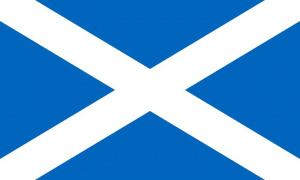Language/Scottish-gaelic/Grammar/How-to-Use-Be
Hi Scottish Gaelic learners! 😊
In this lesson, we will focus on the verb "be" in Scottish Gaelic grammar. "Be" is a highly useful verb and is present in many everyday conversations in Scottish Gaelic. We will go over the different forms of "be" and how to use them in sentences properly. By the end of this lesson, you will be able to use "be" in your speech with ease. So let's dive in!
Introduction[edit | edit source]
The verb "be" is a highly important verb in Scottish Gaelic grammar. It is the equivalent of the English verb "to be." It is used to express existence, describe an object or subject, and it can also change into different tenses to indicate different times, such as past or future.
Don't miss the chance to check out these pages as you wrap up this lesson: Negation & Future Tense.
The Different Forms of "Be"[edit | edit source]
In Scottish Gaelic, "be" has several different forms. The forms include:
| Scottish Gaelic | Pronunciation | English |
|---|---|---|
| tha | ha | am, is, are |
| bha | va | was, were |
| bidh | bee | will be |
| bitheamaid | bee-ha-mitch | will be (plural) |
| bhitheadh | vi-ha | would be |
It is important to note that not all of the aforementioned forms are equivalent to the English "to be." The forms "tha" and "bidh" are more commonly used in everyday conversations while "bha" and "bhitheadh" are mostly used in writing.
How to Use "Tha"[edit | edit source]
"Tha" has four different forms: tha, chan eil, nach eil, and th'. - "Tha" is used to describe a person or object. For example:
- Person 1: Tha an cat sgìth. (The cat is tired.)
- Person 2: Tha sin ceart. (That's right.)
- "Chan eil" is the negative form of "tha." It is used when describing the absence of something or someone. For example:
- Person 1: Chan eil an taigh glan. (The house is not clean.)
- Person 2: Chan eil cuideigin ann? (Is nobody in?)
- "Nach eil" is the interrogative form of "chan eil" and is used to ask a question in the negative form. For example:
- Person 1: Nach eil thu caran sgìth? (Aren't you a bit tired?)
- Person 2: Chan eil. (No.)
- "Th'" is a shortened form of "tha" and is used before a vowel or the letter "fh". For example:
- Person 1: Tha eagal orm. (I am afraid.)
- Person 2: Th' annam an t-acras. (I am hungry.)
How to Use "Bidh"[edit | edit source]
"Bidh" is used to describe an action that will occur in the future. It can also be used to describe a repetitive action or a habit. For example:
- Person 1: Bidh mi a' tighinn thairis gach oidhche. (I will come over every night.)
- Person 2: Bidh an uisgeachan teth gach madainn. (The porridge will be hot every morning.)
How to Use "Bha"[edit | edit source]
"Bha" is used to describe an action that already occurred in the past. For example:
- Person 1: Bha mi a' fuireach ann an Siorrachd Inbhir Nis. (I lived in Inverness-shire.)
- Person 2: Bha sin math. (That was good.)
How to Use "Bitheamaid"[edit | edit source]
"Bitheamaid" is the plural form of "bidh." It is used to describe a future action that involves a group of people. For example:
- Person 1: Bitheamaid a' dèanamh obair carthannais a-màireach. (We will do charity work tomorrow.)
- Person 2: Bitheamaid sin math. (That will be good.)
How to Use "Bhitheadh"[edit | edit source]
"Bhitheadh" is used to describe a hypothetical situation or a conditional statement. For example:
- Person 1: Bhitheadh sin caran truagh. (That would be a bit sad.)
- Person 2: Chan e bhitheadh sin ceart. (That wouldn't be right.)
Dialogue[edit | edit source]
Here is a dialogue to help you see the usage of "be" in context:
- Person 1: Tha an t-uisge air falbh. (The water is gone.)
- Person 2: Bhitheamaid a' dol a-steach airson uisge a cheannach. (We will go inside to buy water.)
- Person 1: Chan eil an dòigh agad air falbh bho seo, nach eil? (You don't know the way gone from here, do you?)
- Person 2: Nach eil. Cha robh mi riamh ann. (No. I've never been there.)
Conclusion[edit | edit source]
In conclusion, the verb "be" plays a vital role in Scottish Gaelic grammar. With this lesson, you have learned how to use "be" in different contexts and how to conjugate it into different tenses. Remember to practice speaking with native speakers on Polyglot Club. You can find native speakers and ask them any questions you have. By doing this, you can improve your proficiency in Scottish Gaelic quickly. You can also check out the [Language/Scottish-gaelic/Grammar|Grammar] section of Scottish Gaelic on Polyglot Club to learn more about Scottish Gaelic grammar. I hope you enjoyed this lesson! 😊
➡ If you have any questions, please ask them in the comments section below.
➡ Feel free to edit this wiki page if you think it can be improved. 😎
Excellent job on conquering this lesson! Consider delving into these related pages: Personal pronouns & Questions.
Other Lessons[edit | edit source]
- Negation
- Give your Opinion
- Adjectives
- Conditional Mood
- Plurals
- Future Tense
- Personal pronouns
- How to Use Have
- Pronouns

